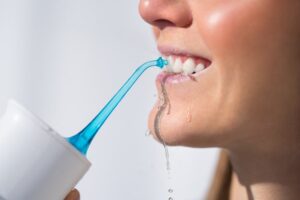Flossing is a crucial step in your oral hygiene routine. Brushing your teeth can clean most of the surface of your teeth. But you will need to floss to remove stubborn plaque and other build-ups and residues between your teeth. Otherwise, you can face a higher risk of cavities and other dental dangers.
Traditional string floss can complete this task adequately. But a water flosser can provide a new, advanced method of clearing away harmful residues in your smile. This device generates a stream of water that washes away tricky plaque between your teeth and near your gumline.
How to Use a Water Flosser
A water flosser can prove highly effective in boosting your oral hygiene and therefore your dental health. But to achieve the maximum benefits, you will need to know how to use this hygienic tool properly. Read on to find advice on how to employ your water flosser to clean your smile.
Choose Appropriate Settings on Your Device
Your water flosser will come with several settings options for you to choose from in order to customize your oral hygiene experience. For instance, you can select from a few options of tips for the flosser that attach to the base where the water stream comes from. Examples include a standard tip, one made to navigate around orthodontics and other oral appliances, and a tip that targets deep in the gum pockets.
The water flosser will also feature different pressure settings that will determine the speed and power of the spray of water generated from the device. Start with the lowest setting and then adjust it as needed to your comfort level.
Navigate the Flosser with Purpose
As with traditional flossing and teeth brushing, you cannot get your mouth as clean as you should by just spraying your water flosser into your mouth without purpose. Make sure you maneuver and aim the water stream from the flosser where needed to remove excess plaque.
Start with the back of the mouth and work your way forward, doing this for the surface of each tooth on each arch and getting between the teeth as well. Consider using your flosser in front of a mirror so that you can see where you aim the device.
Using a water flosser might get messy if you are not prepared. Floss with this device while leaning over a sink. Keep the tip of the flosser between your lips and let the excess water flow over your lips into the sink to avoid making puddles all over your bathroom. You may want to try a cordless water flosser that you can use in the shower to further prevent messes.
The water flosser will not replace the rest of your oral hygiene routine. So make sure you continue to brush your teeth twice a day along with employing this flossing tool daily. Attend teeth cleanings and check-ups at your dentist’s office too to get the best preventative dental care.

